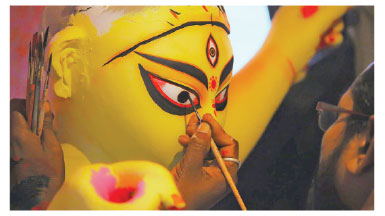
Pranto Chatterjee
There are mornings when the world seems ordinary. But, there are also some mornings when the very air feels touched by eternity. Mahalaya is one such morning. It is the kind of dawn that does not merely break but rather seeps gently into consciousness as if reminding us that time itself carries memory, rhythm and sacred promise. On that day, millions wake up before the sun has even begun to glow, and the silence is pierced by chants that carry centuries within them. Mahalaya is not simply a date on the calendar. It is a bridge. It is a call that binds the living with the departed and prepares the earth for the arrival of the goddess who represents the triumph of good over evil. This year, Mahalaya will fall on the twenty first of September. It will open the gateway to Durga Puja, the grandest festival for Bengali Hindus and one of the most celebrated expressions of faith and culture in South Asia.
To understand Mahalaya is to understand the way human beings relate to time, memory and divinity. The word itself comes from Sanskrit where Maha means great and Alaya means abode or home. Thus Mahalaya becomes the great abode of both remembrance and invocation. It marks the end of Pitru Paksha, a fortnight dedicated to ancestors, and ushers in Devi Paksha, the fortnight when the goddess Durga is welcomed. The transition is powerful. It is as though the solemnity of honouring those who came before prepares the heart for the joy of welcoming the divine mother.

One of the central rituals of Mahalaya is tarpan. At dawn, devotees gather by rivers and ponds, standing barefoot in the cool water, and offer libations of water mixed with sesame seeds, flowers and prayers for the peace of departed souls. It is believed that on this day the ancestors visit the world of the living and accept these offerings before departing satisfied. To the modern eye this may appear as an ancient rite, yet at its core it is simply an act of gratitude. It is the acknowledgment that we are not self-made, that our lives are woven from the sacrifices, efforts and dreams of those who came before.
On Mahalaya morning many artisans put the finishing touch to the clay idols of Durga. The moment of drawing the eyes of the goddess, known as Chokkhu Daan, often coincides with Mahalaya, symbolising that she now sees the world she is about to protect. There is poetry in this gesture, for the clay of the idol comes from earth, the colour from plants and minerals, the form from human creativity, and then at Mahalaya, the goddess is given vision. She sees us, and through her eyes we see ourselves anew.
Perhaps, the most enduring sound of Mahalaya is the recitation of Mahisasura Mardini. For generations the voice of Birendra Krishna Bhadra has been waking up families with Sanskrit verses and evocative narration of Durga’s battle against the demon. Radios still come alive in countless households before dawn, and the younger generation who may have never seen Bhadra still grows up with his voice echoing through corridors. This tradition is more than nostalgia. It is a collective ritual that unites millions. People who may be divided by wealth, geography or status become one in that moment, listening to the same verses, imagining the same goddess, sharing the same anticipation of the festival to come.
Philosophically, Mahalaya invites us to contemplate time itself. Pitru Paksha is about the past. Devi Paksha is about the future. Mahalaya is the bridge in the present. It tells us that human life is always lived in this delicate space between memory and hope. We remember those who came before us and we hope for the victory of good that is yet to come. The goddess descending from the heavens is a metaphor for the possibility of renewal in every age. Just as the clay idol is remade every year, so too can human beings rebuild themselves, societies can repair injustices, and nations can restore harmony.
Mahalaya teaches respect for elders and ancestors, it emphasises the need for courage against evil, it demonstrates the power of collective prayer and collective joy, and it reminds us that art and spirituality are inseparable. In the chants and hymns there is poetry, in the idol making there is sculpture, in the rhythm of the dhaak there is music, in the pandals there is architecture. Faith here becomes inseparable from creativity.
Mahalaya is a whisper and a song, a ritual and a celebration, a grief and a joy. Above all it is a reminder that life itself is sacred, that every dawn carries a story, and that some mornings like Mahalaya are meant to awaken not only the body but also the soul.
__________________________________________________
The writer is an electrical engineer, currently pursuing MSc in Autonomous Vehicle Engineering at the University of Naples Federico II in Italy

